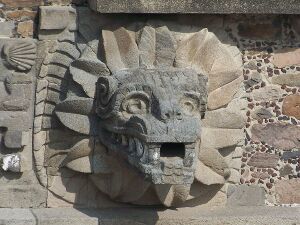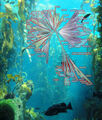Quetzalcoatl (nonfiction)
Quetzalcoatl is a Mesoamerican deity whose name comes from the Nahuatl language and means "feathered serpent".
The worship of a feathered serpent is first known documented in Teotihuacan in the first century BC or first century AD. That period lies within the Late Preclassic to Early Classic period (400 BC – 600 AD) of Mesoamerican chronology, and veneration of the figure appears to have spread throughout Mesoamerica by the Late Classic (600–900 AD).
In the Postclassic period (900–1519 AD), the worship of the feathered serpent deity was based in the primary Mexican religious center of Cholula.
It is in this period that the deity is known to have been named "Quetzalcoatl" by his Nahua followers. In the Maya area he was approximately equivalent to Kukulkan and Gukumatz, names that also roughly translate as "feathered serpent" in different Mayan languages.
Quetzalcoatl, the Aztec god of wind and learning, wears around his neck the "wind breastplate" ehecailacocozcatl, "the spirally voluted wind jewel" made of a conch shell. This talisman was a conch shell cut at the cross-section and was likely worn as a necklace by religious rulers as they have been discovered in burials in archaeological sites throughout Mesoamerica and potentially symbolized patterns witnessed in hurricanes, dust devils, seashells, and whirlpools which were elemental forces that had meaning in the Aztec mythology.
In the News
Red-limned Sea Quetzalcoatl camouflaged as Tree of Life diagram.
Fiction cross-reference
Nonfiction cross-reference
External links:
- Quetzalcoatl @ Wikipedia


